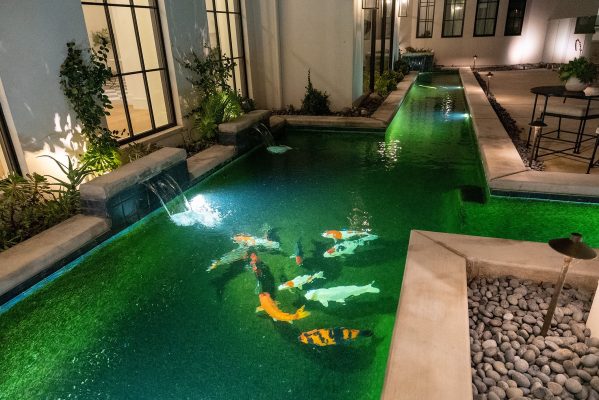Why Keep the Oxygen Level In Your Koi Pond At Or Near the Saturation Point?

Creating a vibrant and thriving environment for koi fish goes beyond providing adequate space and maintaining water quality. One often overlooked aspect is oxygenation, which plays a vital role in the overall health and well-being of these magnificent creatures. By increasing the level of oxygen in a koi pond to or near the saturation level, you can unlock a host of benefits that enhance both the koi and the pond ecosystem. The oxygen saturation point of water refers to the maximum amount of dissolved oxygen that can be present in water under specific conditions, typically at a given temperature and atmospheric pressure. It represents the point at which water can no longer dissolve additional oxygen.
The following will review the advantages of maximizing oxygen levels.
1. Enhanced Fish Health:
Koi thrive in well-oxygenated water. Increasing oxygen levels close to saturation ensures that the fish receive an abundant supply of oxygen, allowing them to respire more efficiently. Adequate oxygenation promotes stronger immune systems, reducing the risk of diseases and enhancing overall fish health. It also aids in wound healing and faster growth, resulting in more vibrant and robust koi.
2. Improved Pond Water Quality:
 Adequate oxygenation in a koi pond goes beyond benefiting the fish; it also plays a crucial role in maintaining a healthy ecosystem. Higher oxygen levels help in breaking down organic matter, reducing the accumulation of harmful toxins such as ammonia and nitrites. Moreover, by stimulating beneficial bacteria, oxygenation supports the breakdown of excess fish waste and reduces the risk of algae blooms, resulting in cleaner, clearer water. By keeping the water quality pristine, you create a more sustainable environment for your koi and other aquatic life.
Adequate oxygenation in a koi pond goes beyond benefiting the fish; it also plays a crucial role in maintaining a healthy ecosystem. Higher oxygen levels help in breaking down organic matter, reducing the accumulation of harmful toxins such as ammonia and nitrites. Moreover, by stimulating beneficial bacteria, oxygenation supports the breakdown of excess fish waste and reduces the risk of algae blooms, resulting in cleaner, clearer water. By keeping the water quality pristine, you create a more sustainable environment for your koi and other aquatic life.
3. Increased Koi Activity and Beauty:
By maintaining high oxygen levels, you encourage greater activity and liveliness among your koi. Well-oxygenated water promotes increased swimming and playful behavior, allowing your koi to exhibit their instincts and vitality. Moreover, optimal oxygenation contributes to the vibrancy of their colors, enhancing the visual appeal and enjoyment of your pond.
4. Prevention of Oxygen Deprivation:

By far, the most common cause of death among koi is a lack of sufficient oxygen. By saturating the pond with oxygen, the risk of oxygen deprivation is minimized. This ensures that fish have access to an abundant oxygen supply at all times. Some medications for treating parasites can consume large amounts of oxygen when used. This can result in the koi becoming lethargic or gasping for air at the pond surface and potential fatalities. Whenever your koi get sick and you end up medicating your pond, having the oxygen level at or near the saturation point can make a big difference in the outcome of your koi. Additionally, the importance of having a backup system to provide oxygen to a pond during a power outage is obvious.
5. Helps Control Algae:
Elevated oxygen levels can help control excessive algae growth in the pond. Algae thrive in low-oxygen environments, and their overgrowth can deplete oxygen levels further, creating a harmful cycle. By maintaining the oxygenation at or near the saturation point, the growth of algae can be suppressed, making it much easier to maintain a clearer and healthier pond environment. This suppression of algae can also take a big load off of your filtration system.
Conclusion:
We are always looking for a way to enhance the health and safety of the koi we sell. In 2020, we decided to create a backup system to oxygenate the ponds in the event of a power outage. In doing this, we also decided to take the oxygen level to the saturation point and maintain that level 24 hours a day. To our surprise, when we brought in the new koi, we noticed right away that they were more active and were eating more. Within one month, we noticed that virtually all the minor sores and fin damage that occur each year from the handling process had all healed up on their own. Finally, we also noticed that at the end of our standard four-month quarantine period, the koi looked healthier and their colors were more vibrant. We had no idea the increased oxygen level would have such a dramatic effect on the koi.

Each year since then, we have noticed the same results. The koi look healthier and have fewer health problems compared to the periods before adding the extra oxygen. Based on our experience, we are convinced that raising the oxygen level to or near the saturation point is a huge step toward creating an ideal koi pond.


